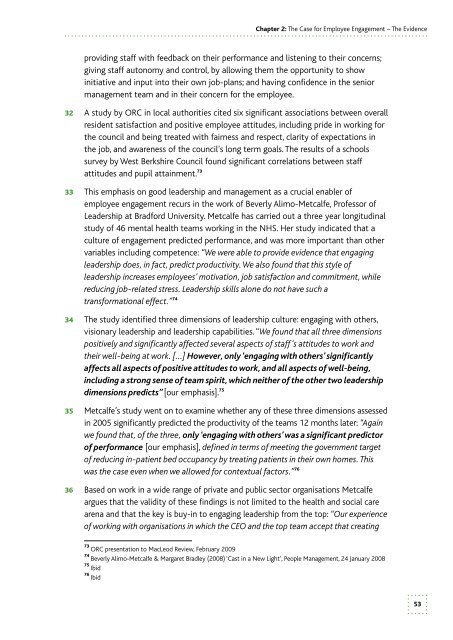3ytgeaf
3ytgeaf
3ytgeaf
Create successful ePaper yourself
Turn your PDF publications into a flip-book with our unique Google optimized e-Paper software.
Chapter 2: The Case for Employee Engagement – The Evidence<br />
providing staff with feedback on their performance and listening to their concerns;<br />
giving staff autonomy and control, by allowing them the opportunity to show<br />
initiative and input into their own job-plans; and having confidence in the senior<br />
management team and in their concern for the employee.<br />
32 A study by ORC in local authorities cited six significant associations between overall<br />
resident satisfaction and positive employee attitudes, including pride in working for<br />
the council and being treated with fairness and respect, clarity of expectations in<br />
the job, and awareness of the council’s long term goals. The results of a schools<br />
survey by West Berkshire Council found significant correlations between staff<br />
attitudes and pupil attainment. 73<br />
33 This emphasis on good leadership and management as a crucial enabler of<br />
employee engagement recurs in the work of Beverly Alimo-Metcalfe, Professor of<br />
Leadership at Bradford University. Metcalfe has carried out a three year longitudinal<br />
study of 46 mental health teams working in the NHS. Her study indicated that a<br />
culture of engagement predicted performance, and was more important than other<br />
variables including competence: “We were able to provide evidence that engaging<br />
leadership does, in fact, predict productivity. We also found that this style of<br />
leadership increases employees’ motivation, job satisfaction and commitment, while<br />
reducing job-related stress. Leadership skills alone do not have such a<br />
transformational effect.” 74<br />
34 The study identified three dimensions of leadership culture: engaging with others,<br />
visionary leadership and leadership capabilities. “We found that all three dimensions<br />
positively and significantly affected several aspects of staff ’s attitudes to work and<br />
their well-being at work. […] However, only ‘engaging with others’ significantly<br />
affects all aspects of positive attitudes to work, and all aspects of well-being,<br />
including a strong sense of team spirit, which neither of the other two leadership<br />
dimensions predicts” [our emphasis]. 75<br />
35 Metcalfe’s study went on to examine whether any of these three dimensions assessed<br />
in 2005 significantly predicted the productivity of the teams 12 months later: “Again<br />
we found that, of the three, only ‘engaging with others’ was a significant predictor<br />
of performance [our emphasis], defined in terms of meeting the government target<br />
of reducing in-patient bed occupancy by treating patients in their own homes. This<br />
was the case even when we allowed for contextual factors.” 76<br />
36 Based on work in a wide range of private and public sector organisations Metcalfe<br />
argues that the validity of these findings is not limited to the health and social care<br />
arena and that the key is buy-in to engaging leadership from the top: “Our experience<br />
of working with organisations in which the CEO and the top team accept that creating<br />
73<br />
ORC presentation to MacLeod Review, February 2009<br />
74<br />
Beverly Alimo-Metcalfe & Margaret Bradley (2008) ‘Cast in a New Light’, People Management, 24 January 2008<br />
75<br />
Ibid<br />
76<br />
Ibid<br />
53


